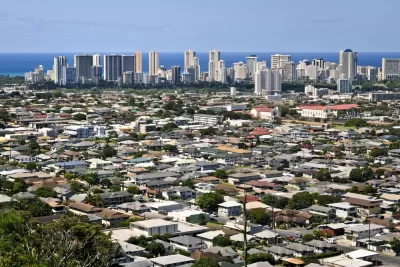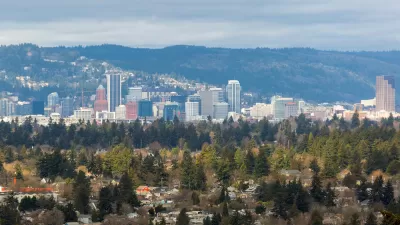Questions of density, and how to add it to single-family neighborhoods, abound in this article focusing on Honolulu and other communities on Oahu.

Stewart Yerton reports for Honolulu Civil Beat on the growing controversies surrounding large homes, built as multi-family dwellings, in traditionally single-family neighborhoods in Oahu.
The article commences with the controversy created by a proposed development for a nine-bedroom house designed to house workers in the Pacific Heights area of Honolulu, home to historic houses and affluent neighbors. Yerton explains the zoning conundrum presented by the home:
The problem is the house was going to be in a quiet residential neighborhood of historic homes. And even if the structure technically met the density criteria allowed by Honolulu’s land-use ordinance, its apparent intended use – as essentially an apartment building or dormitory – simply wouldn’t be allowed in a place zoned for single-family homes.
The development proposal caught the attention of Patrick Smith, president of the Nuuanu/Punchbowl Neighborhood Board, which has an oversight role for the project as part of Oahu’s Neighborhood Board System, established in 1973. "We don’t want our neighborhood having apartment buildings," Smith is quoted as saying in the article.
The neighborhood board succeeded in killing the project, reports Yerton, but the example is far from the only residential development controversy on the island. Residents and policymakers across Oahu are rejecting multi-room houses, "known as 'monster homes,'" amidst a surge in housing costs. The question of how to add density on the island is unanswered, according to the article.
Previous efforts include Bill 7, adopted by the Hawaii State Legislature in 2019. According to Yerton, the bill's incentives for density in the form of redeveloped small homes and under-used, walk-up apartment buildings applies to 7,000 properties in the state but has produced zero new projects. More on Bill 7 is available from an article by Noelle Fujii-Oride for Hawaii Business, published earlier in February 2022.
The source article, linked below, goes into feature depth on the housing development and zoning specifics in Hawaii and Oahu, as well as one architect who recently managed to navigate the Bill 7 "gauntlet."
FULL STORY: More Housing In Honolulu Means More Density. Are Monster Homes The Only Way?

Alabama: Trump Terminates Settlements for Black Communities Harmed By Raw Sewage
Trump deemed the landmark civil rights agreement “illegal DEI and environmental justice policy.”

Study: Maui’s Plan to Convert Vacation Rentals to Long-Term Housing Could Cause Nearly $1 Billion Economic Loss
The plan would reduce visitor accommodation by 25% resulting in 1,900 jobs lost.

Planetizen Federal Action Tracker
A weekly monitor of how Trump’s orders and actions are impacting planners and planning in America.

Wind Energy on the Rise Despite Federal Policy Reversal
The Trump administration is revoking federal support for renewable energy, but demand for new projects continues unabated.

Passengers Flock to Caltrain After Electrification
The new electric trains are running faster and more reliably, leading to strong ridership growth on the Bay Area rail system.

Texas Churches Rally Behind ‘Yes in God’s Back Yard’ Legislation
Religious leaders want the state to reduce zoning regulations to streamline leasing church-owned land to housing developers.
Urban Design for Planners 1: Software Tools
This six-course series explores essential urban design concepts using open source software and equips planners with the tools they need to participate fully in the urban design process.
Planning for Universal Design
Learn the tools for implementing Universal Design in planning regulations.
Caltrans
Smith Gee Studio
Institute for Housing and Urban Development Studies (IHS)
City of Grandview
Harvard GSD Executive Education
Toledo-Lucas County Plan Commissions
Salt Lake City
NYU Wagner Graduate School of Public Service





























